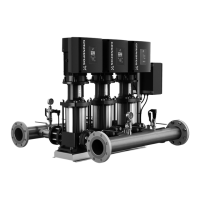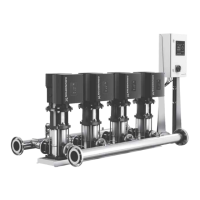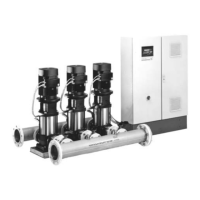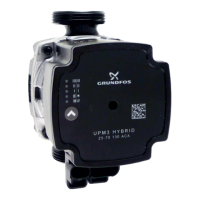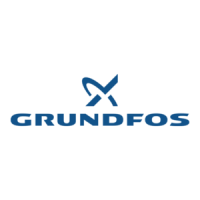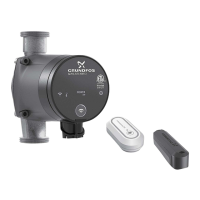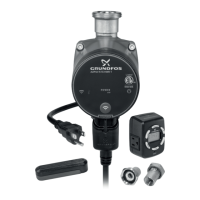Pos. Description
1 Stop pressure
2 Start pressure
In start-stop operation, the pressure varies between the start and
stop pressures.
In User-defined mode (Customised operating mode), ΔH has
been factory-set to 10 % of the actual setpoint. ΔH can be set within
the range from 5 to 30 % of actual setpoint.
The pump changes to start-stop operation if the flow becomes lower
than the minimum flow.
The minimum flow is set in % of the nominal flow of the pump (see
the pump nameplate).
In User-defined mode (Customised operating mode), the
minimum flow has been factory-set to 10 % of nominal flow.
Factory settings
See section Factory settings.
Low-flow detection
Low flow can be detected in two ways:
1. A built-in low-flow detection function which is active if none of
the digital inputs are set for flow switch.
2. A flow switch connected to one of the digital inputs.
• Low-flow detection function: The pump checks the flow regularly
by reducing the speed for a short time. If there is no or only a
small change in pressure, this means that there is low flow. The
speed is increased until the stop pressure (actual setpoint + 0.5
× ΔH) is reached and the pump stops. When the pressure has
fallen to the start pressure (actual setpoint - 0.5 × ΔH), the pump
restarts.
- If the flow is higher than the set minimum flow, the pump
returns to continuous operation at constant pressure.
- If the flow is still lower than the set minimum flow (Q
min
), the
pump continues in start-stop operation until the flow is higher
than the set minimum flow (Q
min
). When the flow is higher
than the set minimum flow rate (Q
min
), the pump returns to
continuous operation.
• Flow switch: When the digital input is activated for more than 5
seconds because there is low flow, the speed is increased until
the stop pressure (actual setpoint + 0.5 × ΔH) is reached, and
the pump stops. When the pressure has fallen to start pressure,
the pump restarts. If there is still no flow, the pump quickly
reaches the stop pressure and stops. If there is flow, the pump
continues operating according to the setpoint.
Set minimum flow
Set the minimum flow (Q
min
) in this display. This setting determines
at which flow rate the system is to change from continuous
operation at constant pressure to start-stop operation. The setting
range is 5 to 30 % of rated flow.
Factory settings
See section Factory settings.
Diaphragm tank volume
The stop function requires a diaphragm tank of a certain minimum
size. Set the size of the installed tank in this display.
In order to reduce the number of start-stops per hour or to reduce
the ΔH, install a large tank.
Install the tank immediately after the pump. The precharge pressure
must be 0.7 × actual setpoint.
Factory settings
See section Factory settings.
Related information
21.6 Factory settings
10.6
Controller
The pumps have a factory default setting of gain (K
p
) and integral
time (T
i
).
However, if the factory setting is not the optimum setting, you can
change the gain and the integral time:
• Set the gain within the range from 0.1 to 20.
• Set the integral-action time within the range from 0.1 to 3600
seconds. If you select 3600 seconds, the controller functions as
a P controller.
Furthermore, you can set the controller to inverse control.
This means that if you increase the setpoint, the speed is reduced.
In the case of inverse control, you must set the gain within the
range from -0.1 to -20.
Guidelines for setting of PI controller
The tables below show the recommended controller settings:
Constant differential pressure
K
p
T
i
0.5 0.5
0.5
L1 < 5 m: 0.5
1)
L1 > 5 m: 3
1)
L1 > 10 m: 5
1)
1)
L1: distance in metres between pump and sensor.
Constant temperature
K
p
T
i
Heating
system
2)
Cooling
system
3)
0.5 - 0.5
10 + 5L2
4)
0.5 -0.5
30 + 5L2
4)
2)
In heating systems, an increase in pump performance results in a rise in
temperature at the sensor.
3)
In cooling systems, an increase in pump performance results in a drop in
temperature at the sensor.
4)
L2: distance in metres between heat exchanger and sensor.
23
English (GB)
